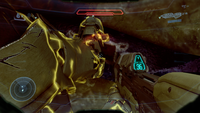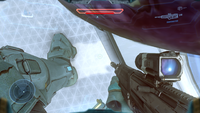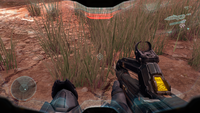Health: Difference between revisions
From Halopedia, the Halo wiki
No edit summary |
|||
| Line 1: | Line 1: | ||
{{Status| | {{Status|Gameplay}} | ||
[[File:HCE Health and shields bars.JPG|300px|thumb|The health and shield indicator in ''Halo: Combat Evolved''. The large, single, blue bar on the top is the shield level.]] | [[File:HCE Health and shields bars.JPG|300px|thumb|The health and shield indicator in ''Halo: Combat Evolved''. The large, single, blue bar on the top is the shield level.]] | ||
'''Health''' in the ''Halo'' games is the player-character's physical well-being. In most games, a player's health is measured and displayed on the [[heads-up display]] (HUD). If a player's health runs out, their character dies | '''Health''' in the ''Halo'' games is the player-character's physical well-being. In most games, a player's health is measured and displayed on the [[heads-up display]] (HUD). If a player's health runs out, their character dies and the player respawns from the last checkpoint in campaign, a random point in free for all multiplayer, or their team's starting point in team based multiplayer gametypes. Lowered health does not affect a player's stamina, movement speed, or other physical attributes. | ||
== Appearances == | == Appearances == | ||
| Line 25: | Line 25: | ||
=== ''Halo 2'' === | === ''Halo 2'' === | ||
Contrary to popular belief, there is a small amount of health in ''[[Halo 2]]'', though it is not explicitly shown on the HUD. Health recharges with a player's shields; this is canonically explained by the presence of [[biofoam]] injectors in the [[MJOLNIR Powered Assault Armor|MJOLNIR]] armor that the [[John-117|Master Chief]] uses in this game. The shield bar appears to change color slightly to reflect the player's health. | Contrary to popular belief, there is a small amount of health in ''[[Halo 2]]'', though it is not explicitly shown on the HUD. Health recharges with a player's shields; this is canonically explained by the presence of [[biofoam]] injectors in the [[MJOLNIR Powered Assault Armor|MJOLNIR]] armor that the [[John-117|Master Chief]] uses in this game, though it is unknown how the [[Arbiter body armor]] heals wounds. The shield bar appears to change color slightly to reflect the player's health. | ||
=== ''Halo 3'' === | === ''Halo 3'' === | ||
Revision as of 16:32, April 7, 2024
Health in the Halo games is the player-character's physical well-being. In most games, a player's health is measured and displayed on the heads-up display (HUD). If a player's health runs out, their character dies and the player respawns from the last checkpoint in campaign, a random point in free for all multiplayer, or their team's starting point in team based multiplayer gametypes. Lowered health does not affect a player's stamina, movement speed, or other physical attributes.
Appearances
Halo: Combat Evolved
Players in Halo: Combat Evolved have a limited, non-regenerating supply of health. Health can only be restored by picking up health packs. Health is shown on the HUD using a horizontal bar broken into eight segments. A player's health can only be reduced if their shields have failed.
In addition to being broken into segments, the health bar changes color to represent the approximate amount of health a player has left. The bar turns yellow when half or more of a player's health has been depleted; when this happens, the player should probably consider obtaining a health pack soon, though the need is not urgent. When only two segments remain on the bar, it will turn red, indicating that the player should find a health pack as soon as possible, and should avoid dangerous situations until then. When only one segment remains, a beating heart sound effect can be heard.
Halo 2
Contrary to popular belief, there is a small amount of health in Halo 2, though it is not explicitly shown on the HUD. Health recharges with a player's shields; this is canonically explained by the presence of biofoam injectors in the MJOLNIR armor that the Master Chief uses in this game, though it is unknown how the Arbiter body armor heals wounds. The shield bar appears to change color slightly to reflect the player's health.
Halo 3
The health system in Halo 3 is a bit more complicated and, like Halo 2, has no visible health bar. Bungie has stated that players have 115 hit points: 45 health points and 70 shield points. When a player's shields fail, their health becomes vulnerable. If the player avoids taking damage for 10 seconds, their health will slowly regenerate at a rate of 9 points per second. Health and shields are independent; a player's shields can regenerate without their health following suit, so full shields do not necessarily mean that a player is safe from death.[1]
Halo 3: ODST
In Halo 3: ODST, players once again have a health bar that is shown on the HUD.[2] A player's health in ODST can only be damaged after their stamina is depleted. Because players play as ODSTs (who are weaker than armored Spartans), health in this game is depleted much faster than in previous games of the series. As in Halo: Combat Evolved, health can only be restored using health packs.
Halo: Reach
In Halo: Reach, Spartans have limited regeneration and a visible health bar. When a Spartan is damaged, after four seconds, his/her health regenerates to the nearest third. If a Spartan is brought down to or below 2/3 health, the remaining health can only be restored by picking up a health pack, or, by using a drop shield.
Elites cannot use health packs, but their health can regenerate completely, though more slowly than a Spartan's regeneration.
Halo 4
In Halo 4, Spartans regenerate very similar to how it was done in Halo 3 and have no visible health bar.
Halo: Spartan Assault
In Halo: Spartan Assault, Spartans regenerate health very similarly to how it is done in Halo 4.
Halo: Spartan Strike
In Halo: Spartan Strike, Spartans regenerate health exactly the same as how it is done in Halo: Spartan Assault.
Halo 5: Guardians
In Halo 5: Guardians, Spartans regenerate health very similarly to how it is done in Halo 4 with the exception of a visible health bar on the HUD. The health bar will be seen flashing red if the player's health reaches 0.3% or lower. If the player plays as John-117, Frederic-104, Kelly-087, or Linda-058, this health bar will be seen flashing red twice as quickly. A flashing red health bar is most easily achievable in Forge by creating and activating a script that damages players equal to 99.7% of their maximum health and then entering said script's trigger area. Scripts are also able to directly deplete the player's/a shielded vehicle's health without affecting their/its shields (though the recharge timer resets).
In the campaign, in most cases, if a character's health does reach 0%, they will not immediately die, but will instead be incapacitated and must be revived within 15 seconds (longer for AI-controlled teammates). If damaged further by weapons (especially explosives, but usually only for AI-controlled Spartans), not revived in time, or if all other Spartans on the fireteam are dead or incapacitated, only then will that character (and all other incapacitated characters) actually die, which also usually results in dialogue from one of the surviving characters saying to hold together (e.g. Fred saying "We lost Chief! Hold position!" if Chief dies, or Buck saying "Tanaka's out! Regroup and hold." if Tanaka dies). However, the dialogue does not occur if a character commits suicide by falling off the map or killing himself/herself with weapons.
In co-op and multiplayer, the energy shield visual effects disappear on a player if his/her health bar turns red without him/her being downed or killed.
The following can also cause a character to instantly die and become unrevivable until they respawn:
- Rocket Launcher (direct hits only)
- Plasma Grenade (only if it sticks)
- Fuel Rod Cannon
- Banshee fuel rods (direct hits only)
- Wraith plasma mortar (except the Ultra Wraith's)
- Binary Rifle
- Incineration Cannon charged shot (except River of Light)
- Phaeton pulse missiles (from both player-controlled and enemy Phaetons)
- Promethean Knight's or Warden Eternal's lightblade slash, or a Hunter's shield bash attack (only if the character is already downed)
- Being in mid-air for too long, being excessively damaged, or being moved too far in any direction right after being downed
- Being in a vehicle when it is destroyed (sometimes, the character will instead be downed right before the vehicle is destroyed)
- Vehicle splatters (even more common on higher difficulties)
- Going into a kill volume, whether instant or timed
Jameson Locke with a red health bar on his HUD after losing his health.
Halo Infinite
In Halo Infinite, the shield and health bars are within the same trapezoidal space, the health bar nested within the bottom-centre of the shield bar with no gap present between the two. If the player has a full shield for 3 seconds, the health bar fades out, leaving only the shield bar, regardless of how much health the player has. It fades in again when the player no longer has a full shield.
Gameplay
Health packs
In the campaign and multiplayer modes of Halo: Combat Evolved, Halo 3: ODST and Halo: Reach, the player's health can be fully replenished by obtaining a single health pack. Health packs do not regenerate shields in Halo: Combat Evolved, but will immediately skip the shield recharging delay in Halo: Reach and will fully replenish the player's stamina in Halo 3: ODST.
Fall damage
In the campaign and multiplayer modes of Halo: Combat Evolved, Halo 3: ODST, Halo: Reach, Halo 4, and Halo 5: Guardians (in the campaign, most often happens to AI-controlled teammates), players can take damage if they fall from too great a height. Such fall damage can kill players who fall from great heights, although fall damage is reduced in Halo 5: Guardians when compared to previous instalments, also with regards to the height required for damage to occur.
Fall damage has a fixed amount of damage, dependent on how far the player falls regardless of any difficulty. Fall speed is also a contributing factor. The faster the player falls, the more health is lost regardless of the height from which the player falls. Rarely, it is possible to prevent fall damage by using certain weapons such as the Gravity Hammer and with the correct timing, negating or decreasing the fall damage.
Fall damage is not present in the campaign and multiplayer of Halo 2, Halo 3, and Halo Infinite, though falling deaths can still result from contact with a kill barrier or when the fall speed is too fast to sustain.
Using Acrophobia Skull in any Halo Game, when the player's speed is exceeding a threshold, it can also cause instant death to the players when bumping into any objects, counting as fall damage.



